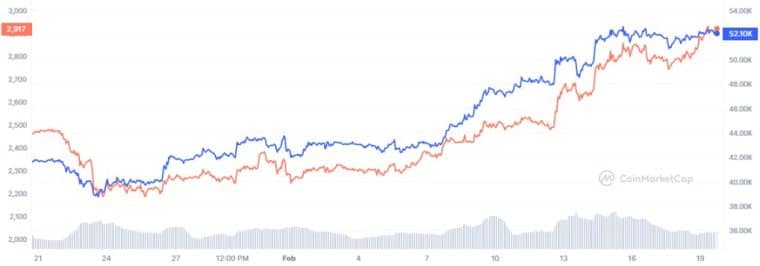As the crypto industry braces for the potential 2024 bull run, the spotlight has increasingly turned towards Ethereum (ETH), the second-largest cryptocurrency by market capitalization, ahead of an anticipated Spot Ethereum ETF. Ethereum fans have long prophesied a “flippening” where ETH’s market cap would catch up to and eventually overtake Bitcoin’s.
They often cite Ethereum’s deflationary tokenomics, its much more diverse utility, its larger developer base, and more as reasons why it should flip Bitcoin. Now they are looking forward to Ethereum getting spot ETFs, driving more institutional and retail money into the asset.
A recent report from the top broker Bernstein suggests that there’s a 50% chance that we could see an approved spot ETH exchange-traded fund (ETF) by May, with the odds nearly certain within the next 12 months.
Ether is “probably the only other digital asset likely to get a spot ETF approval by the SEC,” the report said.
This development comes amidst Ethereum’s notable performance and fundamental shifts that could redefine its market standing relative to Bitcoin (BTC).
Ethereum’s Path to a Spot ETF Approval From the SEC
The possibility of an ETH ETF approval has been a topic of significant interest among crypto investors and analysts alike.
With spot Bitcoin ETFs recently making their debut following months of ambiguity and backtracking by the Securities and Exchange Commission (SEC), the focus has naturally shifted to Ethereum as the next potential candidate for ETF approval.
Major financial institutions, including Franklin Templeton, Blackrock, and Fidelity, have already thrown their hats in the ring, submitting applications for a spot Ethereum ETF. The SEC technically could make a decision on these applications as soon as today, but that is quite unlikely, judging by its reluctance to approve the BTC spot ETFs. Instead, we’ll likely have to wait for the firm deadlines that won’t come for another few months.
Does Ethereum Have a Chance to Flip Bitcoin?

(Bitcoin – Blue, Ethereum – Orange)
While Bitcoin has long been regarded as the premier cryptocurrency, Ethereum has been making strides that could position it as the next “institutional darling.” It has always been a favorite of the crypto community, given that it allows for infinitely more use cases than Bitcoin, from decentralized finance platforms offering lending and borrowing to digital art utilizing NFTs and much more.
Ethereum’s upcoming Dencun upgrade, expected to significantly reduce transaction costs on layer 2 networks, is just one of the catalysts that could propel ETH’s price and adoption further.
Moreover, Ethereum’s shift to a proof-of-stake mechanism (Ethereum 2.0) through ‘The Merge’ has introduced a deflationary aspect to its supply. When the network is busy above a certain threshold, Ethereum is removed from circulation. This is in contrast with Bitcoin’s inflationary supply, even though it halves its inflation rate every 4 years.
Ethereum’s supply dynamics, particularly the net reduction in ETH supply since The Merge, paint a bullish picture for the cryptocurrency.
With over 1 million ETH already burned and a substantial portion of ETH staked in the Ethereum 2.0 contract, Ethereum’s circulating supply is becoming increasingly scarce.
This scarcity, coupled with the anticipated cost reductions from the Dencun upgrade and the potential approval of a spot ETH ETF, positions Ethereum favorably against Bitcoin in terms of fundamental and supply-side dynamics.
I will keep reiterating this until the narrative reaches the mainstream.
The BEST determinant of the ETH ETF is the price of BTC going up and demand for the ETFs going up. $ETH https://t.co/TQJqSgBARC
— Zaheer (@SplitCapital) February 12, 2024
If everything goes right for Ethereum, it could undoubtedly flip Bitcoin eventually, but it won’t be easy. Bitcoin’s market capitalization is over $1 trillion, nearly 3 times larger than Ethereum’s. Bitcoin has a major head start in terms of institutional interest, too, though that could still change if spot ETH ETFs take on.
The Significance of a Spot Ethereum ETF
The approval of an Ethereum ETF could have far-reaching implications for Ethereum and the greater the crypto market.
Similar to the impact of Bitcoin ETFs, an Ethereum ETF would provide investors with a seamless regulated vehicle to easily gain exposure to ETH without the complexities of direct cryptocurrency ownership and storage.
This could attract a new wave of institutional and retail investors to the Ethereum ecosystem, further driving demand and potentially the price of ETH.
Furthermore, Ethereum’s broader utility in decentralized finance (DeFi), non-fungible tokens (NFTs), and other blockchain applications adds another layer of value to its proposition as an investment asset.
Unlike Bitcoin, which is primarily seen as a store of value or “digital gold,” Ethereum’s role as the backbone of a new financial and digital ecosystem could offer additional appeal to investors looking for exposure to the broader crypto market’s growth potential.
The Bottom Line: Ethereum’s Market Prospects
As the crypto market anticipates the SEC’s decision on Ethereum ETF applications, the broader implications for Ethereum and the entire cryptocurrency sector are profound.
An approved spot ETH ETF would not only validate Ethereum’s growing importance in the financial landscape but also mark a significant milestone in the mainstream adoption of cryptocurrencies.
In the meantime, Ethereum’s performance relative to Bitcoin and its evolving fundamentals will continue to attract attention from investors and analysts.
With a 50% chance of an ETH ETF approval by May and a near certainty in the next 12 months, the crypto community remains on the edge of its seat, eagerly watching Ethereum’s journey as it potentially becomes the next institutional darling in the digital asset space.
